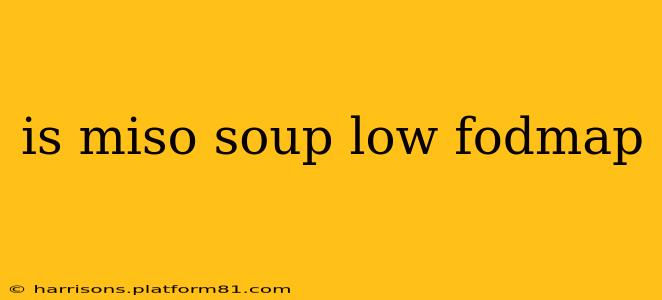Is Miso Soup Low FODMAP? A Comprehensive Guide
Miso soup, a staple in Japanese cuisine, is a delicious and nutritious broth often enjoyed for its savory flavor and potential health benefits. However, for those following a low FODMAP diet to manage symptoms of irritable bowel syndrome (IBS), the question of whether miso soup is suitable arises frequently. The answer, unfortunately, isn't a simple yes or no. It depends on several factors, primarily the type of miso paste used and the serving size.
What are FODMAPs?
Before diving into the specifics of miso soup, let's briefly clarify what FODMAPs are. FODMAPs are fermentable oligosaccharides, disaccharides, monosaccharides, and polyols – essentially, short-chain carbohydrates that can be poorly absorbed in the small intestine. For individuals with IBS, these can trigger digestive distress like bloating, gas, and abdominal pain. A low FODMAP diet involves temporarily restricting high-FODMAP foods to identify trigger foods and then gradually reintroducing them to determine individual tolerances.
Is Miso Paste High or Low FODMAP?
The key ingredient determining whether miso soup is low FODMAP is the miso paste. Miso paste is a fermented soybean product, and different types contain varying levels of FODMAPs.
-
High FODMAP Miso: Many traditional miso pastes, especially those made with barley or wheat, are high in FODMAPs. These include some varieties of awase miso (mixed miso) and those containing barley or wheat koji.
-
Low FODMAP Miso: Generally, white miso (shiro miso) is considered the lowest FODMAP option. This is because it’s typically made from soybeans and rice koji, containing relatively fewer FODMAPs compared to other types. However, even with white miso, portion size is crucial.
What about the other ingredients in Miso Soup?
While miso paste is the primary concern, other ingredients can also contribute to the overall FODMAP content of your soup. Consider these factors:
-
Dashi (Broth): Traditionally made with kombu (kelp) and bonito flakes (skipjack tuna), dashi is generally low FODMAP in moderate amounts. However, some commercially produced dashi broths may contain added ingredients that could be high in FODMAPs, so always check the label.
-
Vegetables: Many vegetables commonly found in miso soup, like mushrooms, spinach, and seaweed, are generally low FODMAP in small portions. But larger portions or certain types, such as onions or garlic, would raise the FODMAP level considerably.
-
Tofu: Firm or silken tofu is usually considered low FODMAP.
How much Miso Soup is considered Low FODMAP?
Even with low-FODMAP white miso, it's essential to control portion sizes. A typical serving size of miso soup on a low-FODMAP diet would be around 1/2 to 1 cup, depending on individual tolerance. Consuming larger portions may trigger symptoms in sensitive individuals.
Is Miso Soup Safe for Everyone on a Low FODMAP Diet?
No, miso soup isn't automatically safe for everyone on a low FODMAP diet. Its suitability depends entirely on the ingredients and the serving size. Always carefully check the labels of your miso paste and other ingredients to ensure they're suitable for your dietary needs.
Can I make low-FODMAP miso soup at home?
Yes, you can make a low-FODMAP miso soup by carefully selecting your ingredients. Use white miso, a low-FODMAP dashi (or vegetable broth), and small amounts of low-FODMAP vegetables.
This detailed guide clarifies the complexities of miso soup and the low FODMAP diet. Remember, individual tolerances vary, so always listen to your body and adjust your intake accordingly. If you're uncertain, consult with a registered dietitian or gastroenterologist specializing in IBS and the low FODMAP diet for personalized guidance.
